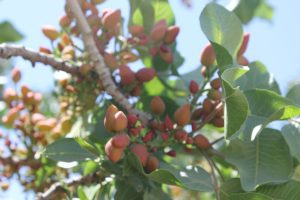
I hope the holidays were festive, fun and full of all the family you could handle. Now get back to work! As farmers, we don’t get a whole lot of time off. Being January, almond bloom is not very far off. Then it won’t be long until all the other crops follow suit. Let’s make a plan, and more importantly this year, alter it and make sure it’s working.
Just Enough Inputs
Being a crop advisor in addition to farming my own pistachios, I am acutely aware of the rising prices for fertilizer. We need to be mindful of our inputs to ensure we aren’t adding anything to our soil that our crops aren’t picking up. Let’s take a deeper dive into what that means. What did your crops yield last year? Sit down with your crop advisor and calculate the removal rates. Add to that what it takes to just grow your trees let alone the crops. A great resource for that can be found at the UC ANR website. Now look at your soils and see what the soil was supposed to release in the parts per million section. Calculate your total inputs for the season. Now look at your tissue samples and see what you were deficient in. How was that specific nutrient supplied and at what time of the year? Did you acidify your spray water below 7 before applying the nutrition foliarly? What was the pH of the water used to apply fertigations? How long did you run those sets that nutrition was applied? If you have soil moisture sensors, how far did the water move in that set? Was it below 12” to 18” or below the active root zone? How long did that soil stay wet and let the roots sit in anaerobic conditions? Were specific nutrients applied when those ‘specific nutrients’ were in demand for your trees and crop?
Let’s run a quick example with nitrogen. If we use the standard rule that tree nuts can only take up about 10 units N per week, what happens when we apply 50 units in one fertigation? Assuming a 70% use efficiency, if a crop can take up 10 units per acre, we actually only need to apply 13 units that week. We put on 50. How’s that going to work out for us? Let’s say it’s UAN-32 which has a total N load of 3.54 pounds per gallon. We would have applied 14.1 gallons per acre in that fertigation according to the math. The nitrate content of that fertilizer is 0.86 pounds per gallon. That’s 12.14 units of just nitrate N in that total application. Let’s hope all of that got absorbed in that irrigation. When we check our irrigation, we see that water went down to 24”. Let’s just pray the urea portion (1.82 pounds N per gallon) and the ammoniacal portion of N (0.86 pounds per gallon) didn’t rinse all the way through to those 2 feet. There aren’t many active feeder roots that far down. And how long will it take the biology to transform that N into nitrate in anaerobic conditions? How much of that urea volatilized? My point in all of this is that our inefficiencies in large slugs may be costing us serious money. Yet, we still probably have plenty of N. Did we need all of that? Maybe we did if we aren’t applying it correctly. Let’s change that.

Look at the Tissues
Rarely do I see any crops that are deficient in N. If your N levels are elevated and all your other nutrients are just at sufficiency levels, they aren’t balanced. Unbalanced nutrition is not efficient. Often, those imbalances create undesirable results like more vegetative growth instead of making crops. Let’s dig a little deeper on other nutrients. How often do you apply calcium? Remember, your crops need as much or more Ca every year as N. If you are getting your Ca in the form of CAN-17, that’s only half of what you need to keep up with N (17% N and 9% Ca). If you’re trying to rely on former gypsum applications or lime, you better be sure your water is below 6.5 pH and you’ve reduced the carbonates or it’s not going to release the 4000 ppm your soil test shows. The math says you need the tissues to have 10% to 15% of the N total in magnesium, 25% of the N total in sulfur, 80% of the N total in potassium, etc. Are we actually balancing nutrients or just overapplying one that is now costing us a lot more money?
Alright, enough of the questions and “what-ifs”. However, desperate times call for desperate measures. If we can reduce our inputs significantly and match actual demand at critical times, we can keep yields up and input prices lower. Oh, and one more thing (I feel like Columbo!): Let’s get it right early in the season this year. Giving a balanced dose of the nutrients the trees need early allows them to set themselves up. Our trees are stuck right where we put them, so we must make sure the nutrition gets to them in the proper amounts. If bloom is successful and the trees have what they need for cell division and great big green solar panels, they can do more of the heavy lifting the rest of the year. If we start deficient, we will be chasing it the rest of the season. It’s better to get them off to a good start and give the trees what they need to work as hard as we do.














